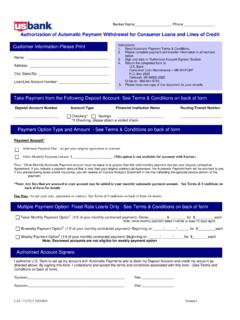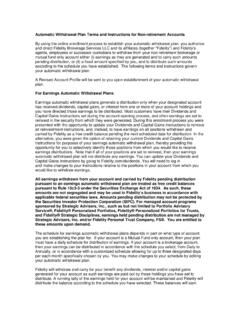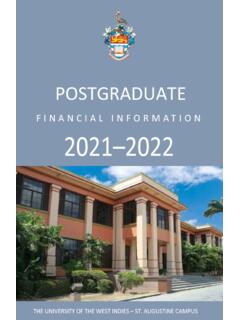Transcription of Common Reporting Standard XML Schema - OECD
1 Common Reporting Standard XML Schema : User Guide for Tax Administrations Version June 2019 PUBE This document and related XML Schema , as well as any data and any map included herein, are without prejudice to the status of or sovereignty over any territory, to the delimitation of international frontiers and boundaries and to the name of any territory, city or area. This document was approved by the Committee on Fiscal Affairs on 5 April 2019 and prepared for publication by the OECD Secretariat. Please cite this publication as: OECD (2019), Common Reporting Standard XML Schema : User Guide for Tax Administrations, Version June 2019, OECD, Paris. - The statistical data for Israel are supplied by and under the responsibility of the relevant Israeli authorities. The use of such data by the OECD is without prejudice to the status of the Golan Heights, East Jerusalem and Israeli settlements in the West Bank under the terms of international law.
2 Note by Turkey The information in the related XML Schema with reference to Cyprus relates to the southern part of the Island. There is no single authority representing both Turkish and Greek Cypriot people on the Island. Turkey recognises the Turkish Republic of Northern Cyprus (TRNC). Until a lasting and equitable solution is found within the context of the United Nations, Turkey shall preserve its position concerning the Cyprus issue . Note by all the European Union Member States of the OECD and the European Union The Republic of Cyprus is recognised by all members of the United Nations with the exception of Turkey. The information in the related XML Schema relates to the area under the effective control of the Government of the Republic of Cyprus. Photo credits: Cover OECD 2019 You can copy, download or print OECD content for your own use, and you can include excerpts from OECD publications, databases and multimedia products in your own documents, presentations, blogs, websites and teaching materials, provided that suitable acknowledgement of OECD as source and copyright owner is given.
3 All requests for public or commercial use and translation rights should be submitted to Common Reporting Standard XML Schema : USER GUIDE OECD 2019 FOREwORD 3 ForewordThis third version of the Common Reporting Standard (CRS) XML Schema User Guide reflects a number of technical changes that have been made to the CRS XML Schema , following input from jurisdictions and financial institutions using the Schema . The main technical changes, compared to the previous version released in 2017 relate to the use of the Message Reference ID, the indicator for the message type and the length of string elements. The Schema can now also be used for nil Reporting /zero data messages between tax authorities. In addition, the ISO country and currency lists have been updated to reflect the most recent developments in this into account the implementation time needed, this second version of the CRS XML Schema will be used for all exchanges ( new data, as well as corrections and deletions) as from 1 January 2021.
4 After that time, the current, first version of the CRS XML Schema should no longer be Reporting Standard XML Schema : USER GUIDE OECD 2019 TABLE OF CONTENTS 5 Table of contentsAbbreviations and acronyms ..7 Annex 3. Common Reporting Standard User Guide ..9 Appendix A. CRS XML Schema Diagrams..45 Appendix B. Glossary of Namespaces ..63 Common Reporting Standard XML Schema : USER GUIDE OECD 2019 ABBREvIATIONS AND ACRONyMS 7 Abbreviations and acronymsCRS Common Reporting StandardCRS MCAA CRS Multilateral Competent Authority AgreementCTS Common Transmission SystemFATCA Foreign Account Tax Compliance ActFI Financial InstitutionOECD Organisation for Economic Co-operation and DevelopmentCOMMON Reporting Standard XML Schema : USER GUIDE OECD 2019 ANNEX 3. Common Reporting Standard USER GUIDE 9 Annex 3 Common Reporting Standard User GuideVersion (CRS Schema version )IntroductionThe OECD working with G20 countries has developed a Common Standard on Reporting , due diligence and exchange of financial account information .
5 Under this Common Standard , jurisdictions obtain from Reporting financial institutions and automatically exchange with exchange partners, as appropriate, on an annual basis financial information with respect to all reportable accounts, identified by financial institutions on the basis of Common Reporting and due diligence of the technical solution to support this Common Standard is a Schema and related Schema is a data structure for holding and transmitting information electronically and in bulk. XML extensible markup language is commonly used for this purpose. Examples are the OECD s Standard Transmission Format STF or the Fisc 153 format used for information exchange for the European Savings User Guide explains the information required to be included in each CRS data element to be reported in the CRS XML Schema It also contains guidance on how to make corrections of data items within a file that can be processed the CRS User Guide links to the CRS SchemaThis User Guide is divided into logical sections based on the Schema and provides information on specific data elements and any attributes that describe that data CRS Schema information sections areI.
6 Message Header with the sender, recipient, message type, Reporting periodII. Controlling Person or Account Holder details if an individualIII. Account Holder if an entityI v. Iv CRS Body; Reporting FI and Reporting Group and Account detailsThe numbers of the sections are reflected in the numbering of the diagrams in Appendix Reporting Standard XML Schema : USER GUIDE OECD 201910 ANNEX 3. Common Reporting Standard USER GUIDEThe CRS XML Schema is designed to be used for the automatic exchange of financial account information between Competent Authorities ( CAs ). In addition the CRS could also be used for domestic Reporting by Financial Institutions ( FIs ) to domestic tax authorities under the CRS. Items relevant for domestic Reporting only are shown in [brackets].The CRS Schema is re-using the FATCA Schema and elements of STF, so there are some elements in the CRS Schema that are not required for purposes of Reporting and exchange under the CRS ( Pool Report and Nationality).
7 These elements are shown in the User Guide as optional, followed by non-CRS .The comment non-CRS is also shown on the Appendix A diagrams where CRS XML Schema and its User Guide provide for elements that are unique to CRS undocumented and closed requirement field for each data element and its attribute indicates whether the element is validation or optional in the Schema . Every element is one or the other in the Schema . validation elements MUST be present for ALL data records in a file and an automated validation check can be undertaken. The Sender should do a technical check of the data file content using XML tools to make sure all validation elements are present and if they are not, correct the file. The Receiver may also do so and if incorrect, may reject the file. where there is a choice between 2 validation elements under a validation parent and only one is needed, this is shown as validation (choice) . If the elements are under an optional parent, they are shown as may be different business rules for elements that are optional in the Schema : Some optional fields are shown as (Optional) Mandatory an optional element that is required for CRS Reporting as specified in CRS Reporting requirements depending on availability of information or legal factors.
8 Mandatory elements may be present in most (but not all) circumstances, so there cannot be a simple IT validation process to check these. ( the CRS provides that a Reporting FI is required to report the TIN of an Account Holder only if issued by his jurisdiction of residence/place of birth only if otherwise required to retain and report and is held in electronically searchable records). Optional elements may represent a choice between one type or another, where one of them must be used ( choice between address fix or address free). Shown as Optional requirement. The element may not be required for either Schema validation or CRS. It should not be reported in a CRS only file as indicated by Optional (non CRS) .Appendix A to the CRS User Guide shows a diagrammatic representation of the CRS XML Schema with all its elements. The numbers next to the headings are the corresponding section numbers in the User Guide B to the CRS User Guide contains a Glossary of namespaces for the CRS XML Reporting Standard XML Schema : USER GUIDE OECD 2019 ANNEX 3.
9 Common Reporting Standard USER GUIDE 11 Common Reporting Standard Schema InformationI. Message HeaderInformation in the message header identifies the tax administration that is sending the message. It specifies when the message was created, what period (normally a year) the report is for, and the nature of the report (original, corrected, supplemental, etc.).ElementAttributeSizeInput TypeRequirementSendingCompanyIN1 to 200 charactersstf:StringMin1 Max200_TypeOptional[Although not used for exchange between Competent Authorities under CRS, for domestic Reporting the Sending Company Identification Number element would be Mandatory and would identify the Financial Institution Reporting to the Sending tax authority by domestic TIN (or IN).]ElementAttributeSizeInput TypeRequirementTransmittingCountry2-char acteriso:CountryCode_TypeValidationThis data element identifies the jurisdiction where the reported financial account is maintained or where the reported payment is made by the Reporting FI.
10 If the sender is a tax administration, the transmitting country is the jurisdiction of the tax administration. This data element uses the 2-character alphabetic country code and country name list1 based on the ISO 3166-1 Alpha 2 Standard .[For domestic Reporting this element would be the domestic Country code .]ElementAttributeSizeInput TypeRequirementReceivingCountry2-charact eriso:CountryCode_TypeValidationThis data element identifies the jurisdiction of the tax administration (the Competent Authority) that is the intended recipient of the message. This data element uses the 2-character alphabetic country code based on the ISO 3166-1 Alpha 2 Standard .[For domestic Reporting this element would be the domestic Country code .]ElementAttributeSizeInput TypeRequirementMessageTypecrs:MessageTyp e_EnumTypeValidationThis data element specifies the type of message being sent. The only allowable entry in this field for CRS AEOI is CRS.













